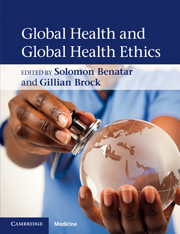Book contents
- Frontmatter
- Contents
- List of contributors
- Introduction
- Section 1 Global health, definitions and descriptions
- Section 2 Global health ethics, responsibilities and justice: some central issues
- Section 3 Analyzing some reasons for poor health
- 12 Trade and health: the ethics of global rights, regulation and redistribution
- 13 Debt, structural adjustment and health
- 14 The international arms trade and global health
- 15 Allocating resources in humanitarian medicine
- 16 International aid and global health
- 17 Climate change and health: risks and inequities
- 18 Animals, the environment and global health
- 19 The global crisis and global health
- Section 4 Shaping the future
- Index
- References
16 - International aid and global health
Published online by Cambridge University Press: 01 March 2011
- Frontmatter
- Contents
- List of contributors
- Introduction
- Section 1 Global health, definitions and descriptions
- Section 2 Global health ethics, responsibilities and justice: some central issues
- Section 3 Analyzing some reasons for poor health
- 12 Trade and health: the ethics of global rights, regulation and redistribution
- 13 Debt, structural adjustment and health
- 14 The international arms trade and global health
- 15 Allocating resources in humanitarian medicine
- 16 International aid and global health
- 17 Climate change and health: risks and inequities
- 18 Animals, the environment and global health
- 19 The global crisis and global health
- Section 4 Shaping the future
- Index
- References
Summary
Introduction
Nancy Birdsall (2008) has described Overseas Development Assistance (ODA) as being guilty of “seven deadly sins.” Her critique exposes many weaknesses of the international aid system. How applicable are these “sins” to development assistance for global health? How do we make sense of the contradictions regarding the value and utility of ODA and the critiques of how it operates? And, most importantly, how might “we” do better?
This chapter explores the nature of foreign aid, as it relates to global health, and seeks to assess its value(s) and constraints. The chapter is structured around four key elements: (a) trends in overseas development assistance for health; (b) motivations and influences on aid; (c) an assessment of current aid structures and approaches and (d) emerging issues, considerations and recommendations.
Background
The world's club of wealthy countries, the Organisation for Economic Co-operation and Development (OECD), noted as “outrageous” the ongoing human tragedy of failed development: 9 million avoidable deaths in those under 5 years of age and 536,000 maternal deaths per year (OECD, 2009). Widespread acknowledgment of limited achievements of international aid, a decade earlier, led to agreement at the Millennium Summit to establish global targets for development, the Millennium Development Goals (MDGs). These comprised a set of eight inter-related development goals designed to close the poverty gap between rich and poor countries and to improve the health and well-being of over a billion people living on less than $1 per day (see www.un.org/millenniumgoals/).
- Type
- Chapter
- Information
- Global Health and Global Health Ethics , pp. 184 - 197Publisher: Cambridge University PressPrint publication year: 2011
References
- 4
- Cited by



